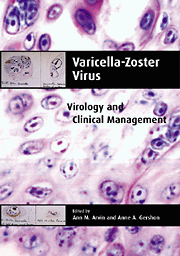Book contents
- Frontmatter
- Contents
- List of contributors
- Preface
- Introduction
- Part I History
- Part II Molecular Biology and Pathogenesis
- Part III Epidemiology and Clinical Manifestations
- 10 Epidemiology of varicella
- 11 Clinical manifestations of varicella
- 12 Epidemiology of herpes zoster
- 13 Clinical manifestations of herpes zoster
- 14 Ophthalmic zoster
- 15 Postherpetic neuralgia and other neurologic complications
- 16 Varicella and herpes zoster in pregnancy and the newborn
- Part IV Laboratory Diagnosis
- Part V Treatment and Prevention
- Index
- Plate section
14 - Ophthalmic zoster
from Part III - Epidemiology and Clinical Manifestations
Published online by Cambridge University Press: 02 March 2010
- Frontmatter
- Contents
- List of contributors
- Preface
- Introduction
- Part I History
- Part II Molecular Biology and Pathogenesis
- Part III Epidemiology and Clinical Manifestations
- 10 Epidemiology of varicella
- 11 Clinical manifestations of varicella
- 12 Epidemiology of herpes zoster
- 13 Clinical manifestations of herpes zoster
- 14 Ophthalmic zoster
- 15 Postherpetic neuralgia and other neurologic complications
- 16 Varicella and herpes zoster in pregnancy and the newborn
- Part IV Laboratory Diagnosis
- Part V Treatment and Prevention
- Index
- Plate section
Summary
Involvement of the trigeminal nerve in recurrent varicella-zoster virus (VZV) infection (herpes zoster ophthalmicus, HZO) is second in frequency only to thoracic zoster but can exact a much greater toll in terms of long term complications and marked disruption of the quality of life.
Epidemiology
Of the one million doctor visits for zoster in the United States annually, up to 250000 involve the eye and, of those, 50–72% suffer chronic, recurring ocular disease and visual loss. Disturbance of cell-mediated immunity (CMI) is a critical precipitating factor, with the incidence of zoster now increasing due to the HIV epidemic, an aging population, and other causes of immunosuppression (Hope- Simpson, 1965; Ragozzino et al., 1982; Harding et al., 1987; Donahue et al., 1995; Weller, 1995; Pepose, 1997).
In a 1975 to 1980 study of 86 cases of HZO, Womack & Liesegang (1983) reported a predominance in female patients, involvement of the left eye, and a peak incidence in the seventh and eighth decades of life. This differed from other series showing a male predominance or equal distribution between the sexes and a peak incidence in the fourth or fifth to the seventh decade of life (Edgerton, 1945; Scott, 1957; Scheie, 1970; Donahue et al., 1995; Pavan-Langston & Dunkel, 1996). In all these studies ocular involvement ranged from 50 to 72%.
Pathogenesis and histopathology of HZO
Mahalingam et al. (1990, 1993), reported that after primary infection with varicella, VZV becomes latent far more often in the trigeminal than in any thoracic ganglion, the most common area involved clinically. They estimated that 10–25% of all zoster infections involve the eye.
- Type
- Chapter
- Information
- Varicella-Zoster VirusVirology and Clinical Management, pp. 276 - 298Publisher: Cambridge University PressPrint publication year: 2000
- 4
- Cited by



